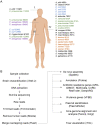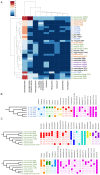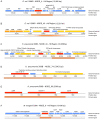Combining Functional Genomics and Whole-Genome Sequencing to Detect Antibiotic Resistance Genes in Bacterial Strains Co-Occurring Simultaneously in a Brazilian Hospital
- PMID: 33920372
- PMCID: PMC8070361
- DOI: 10.3390/antibiotics10040419
Combining Functional Genomics and Whole-Genome Sequencing to Detect Antibiotic Resistance Genes in Bacterial Strains Co-Occurring Simultaneously in a Brazilian Hospital
Abstract
(1) Background: The rise of multi-antibiotic resistant bacteria represents an emergent threat to human health. Here, we investigate antibiotic resistance mechanisms in bacteria of several species isolated from an intensive care unit in Brazil. (2) Methods: We used whole-genome analysis to identify antibiotic resistance genes (ARGs) and plasmids in 34 strains of Gram-negative and Gram-positive bacteria, providing the first genomic description of Morganella morganii and Ralstonia mannitolilytica clinical isolates from South America. (3) Results: We identified a high abundance of beta-lactamase genes in resistant organisms, including seven extended-spectrum beta-lactamases (OXA-1, OXA-10, CTX-M-1, KPC, TEM, HYDRO, BLP) shared between organisms from different species. Additionally, we identified several ARG-carrying plasmids indicating the potential for a fast transmission of resistance mechanism between bacterial strains. Furthermore, we uncovered two pairs of (near) identical plasmids exhibiting multi-drug resistance. Finally, since many highly resistant strains carry several different ARGs, we used functional genomics to investigate which of them were indeed functional. In this sense, for three bacterial strains (Escherichia coli, Klebsiella pneumoniae, and M. morganii), we identified six beta-lactamase genes out of 15 predicted in silico as those mainly responsible for the resistance mechanisms observed, corroborating the existence of redundant resistance mechanisms in these organisms. (4) Conclusions: Systematic studies similar to the one presented here should help to prevent outbreaks of novel multidrug-resistant bacteria in healthcare facilities.
Keywords: antibiotic resistance genes; functional genomics; mobilome; resistome; whole-genome analysis.
Conflict of interest statement
The authors declare no conflict of interest.
Figures








Similar articles
-
[Analysis of antibiotic resistance and genotypes on extended spectrum β-lactamase and AmpC β-lactamase producing strains isolated from Uygur and Han newborns].Zhonghua Yu Fang Yi Xue Za Zhi. 2011 Mar;45(3):217-24. Zhonghua Yu Fang Yi Xue Za Zhi. 2011. PMID: 21624232 Chinese.
-
Genomic analysis of two drug-resistant clinical Morganella morganii strains isolated from UTI patients in Pretoria, South Africa.Lett Appl Microbiol. 2020 Jan;70(1):21-28. doi: 10.1111/lam.13237. Epub 2019 Nov 8. Lett Appl Microbiol. 2020. PMID: 31630429
-
First characterisation of plasmid-mediated quinolone resistance-qnrS1 co-expressed bla CTX-M-15 and bla DHA-1 genes in clinical strain of Morganella morganii recovered from a Tunisian Intensive Care Unit.Indian J Med Microbiol. 2012 Oct-Dec;30(4):437-41. doi: 10.4103/0255-0857.103765. Indian J Med Microbiol. 2012. PMID: 23183469
-
Multi-drug carbapenem-resistant Klebsiella pneumoniae infection carrying the OXA-48 gene and showing variations in outer membrane protein 36 causing an outbreak in a tertiary care hospital in Riyadh, Saudi Arabia.Int J Infect Dis. 2014 Nov;28:186-92. doi: 10.1016/j.ijid.2014.05.021. Epub 2014 Sep 19. Int J Infect Dis. 2014. PMID: 25245001
-
Whole Genome Sequencing of Extended Spectrum β-lactamase (ESBL)-producing Klebsiella pneumoniae Isolated from Hospitalized Patients in KwaZulu-Natal, South Africa.Sci Rep. 2019 Apr 18;9(1):6266. doi: 10.1038/s41598-019-42672-2. Sci Rep. 2019. PMID: 31000772 Free PMC article.
Cited by
-
Nosocomial Outbreak of Extensively Drug-Resistant (Polymyxin B and Carbapenem) Klebsiella pneumoniae in a Collapsed University Hospital Due to COVID-19 Pandemic.Antibiotics (Basel). 2022 Jun 17;11(6):814. doi: 10.3390/antibiotics11060814. Antibiotics (Basel). 2022. PMID: 35740220 Free PMC article.
-
Antibiotics and Antimicrobials Resistance: Mechanisms and New Strategies to Fight Resistant Bacteria.Antibiotics (Basel). 2022 Mar 17;11(3):400. doi: 10.3390/antibiotics11030400. Antibiotics (Basel). 2022. PMID: 35326863 Free PMC article.
References
-
- Pancholi P., Carroll K.C., Buchan B.W., Chan R.C., Dhiman N., Ford B., Granato P.A., Harrington A.T., Hernandez D.R., Humphries R.M., et al. Multicenter Evaluation of the Accelerate PhenoTest BC Kit for Rapid Identification and Phenotypic Antimicrobial Susceptibility Testing Using Morphokinetic Cellular Analysis. J. Clin. Microbiol. 2018;56 doi: 10.1128/JCM.01329-17. - DOI - PMC - PubMed
-
- Köser C.U., Ellington M.J., Cartwright E.J.P., Gillespie S.H., Brown N.M., Farrington M., Holden M.T.G., Dougan G., Bentley S.D., Parkhill J., et al. Routine Use of Microbial Whole Genome Sequencing in Diagnostic and Public Health Microbiology. PLoS Pathog. 2012;8:e1002824. doi: 10.1371/journal.ppat.1002824. - DOI - PMC - PubMed
-
- Adams M.D., Goglin K., Molyneaux N., Hujer K.M., Lavender H., Jamison J.J., Macdonald I.J., Martin K.M., Russo T., Campagnari A.A., et al. Comparative Genome Sequence Analysis of Multidrug-Resistant Acinetobacter baumannii. J. Bacteriol. 2008;190:8053–8064. doi: 10.1128/JB.00834-08. - DOI - PMC - PubMed
Grants and funding
- 2015/04309-1/Fundação de Amparo à Pesquisa do Estado de São Paulo
- 2019/15675-0/Fundação de Amparo à Pesquisa do Estado de São Paulo
- 2019/00390-0/Fundação de Amparo à Pesquisa do Estado de São Paulo
- 2018/18158-3/Fundação de Amparo à Pesquisa do Estado de São Paulo
- 2016/18827-7/Fundação de Amparo à Pesquisa do Estado de São Paulo
LinkOut - more resources
Full Text Sources
Other Literature Sources

